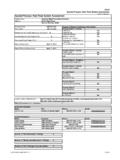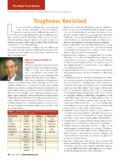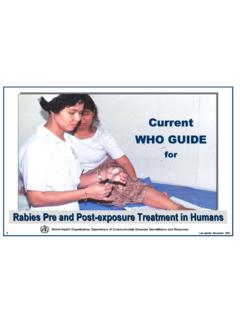Transcription of Applying Study Results to Patient Care: Glossary of …
1 Detail-Document #200512. This Detail-Document accompanies the related article published in .. PHARMACIST'S LETTER / PRESCRIBER'S LETTER. May 2004 ~ Volume 20 ~ Number 200512. Applying Study Results to Patient care : Glossary of Study Design and Statistical Terms Lead author: Jill Allen, , BCPS. Continue to the next section for practical applications of medical statistics followed by our chart, Drug Therapy of Common Conditions and Number Needed to Treat . Absolute risk reduction: The absolute studies with positive outcomes are overly difference in rates of an outcome between represented. treatment and control groups in a clinical trial. Recall bias: People may remember things Example: A hypothetical clinical trial compares differently than how they occurred.
2 The effect of a new statin and placebo on the Selection bias: Differences between treatment incidence of stroke. Over the course of the Study , and control groups that result from the way the incidence of stroke is 4% with the statin and patients were selected. Randomization and 6% with placebo. The absolute risk reduction blinding should help prevent selection bias. with the statin is 2%. Blinding: In a double-blind clinical trial, neither Alpha: The probability of concluding there is a the investigator nor the Patient knows which difference between groups when there really is no treatment group they are assigned to. If patients difference between them (making a type I error). or investigators know what group they are A result is usually considered statistically assigned to, they may report better Results with significant if the probability of a type I error is active treatment and worse Results with placebo.
3 Less than 5% (p< ). This (p< ) means that In an open-label Study , all patients receive active the probability that the result is due to chance is treatment (there is no placebo group) and both the less than 1 in 20. The smaller the p-value, the Patient and the investigator know this. Open-label greater the statistical significance. studies tend to overestimate efficacy. Beta: The probability of concluding that there is Case-control Study : A Study which selects no difference between treatment groups when patients who have the outcome of interest (cases). there really is a difference (making a type II and patients without that outcome (controls), and error). looks back in time to identify characteristics that are linked to the outcome in case patients .
4 Case- Bias: Flaws in the design or operation of a Study control studies are retrospective. that lead to overestimation of the efficacy of treatment. Bias can more easily be introduced Clinical significance: Study Results that are into studies that are not blinded. There are many important enough to implement in clinical different ways in which bias can be introduced practice. Some studies are so large that very small into a Study . differences between groups are statistically Publication bias: Investigators tend not to publish significant. But the magnitude of the benefit may studies with negative outcomes. This can lead to be so small that it isn't worthwhile to adopt in overestimation of efficacy in meta-analysis when clinical practice.
5 More.. Copyright 2004 by Therapeutic Research Center Pharmacist's Letter / Prescriber's Letter ~ Box 8190, Stockton, CA 95208 ~ Phone: 209-472-2240 ~ Fax: 209-472-2249. ~ (Detail-Document #200512: Page 2 of 14). Cohort: A group of patients or Study subjects. Effectiveness: How well a drug works in every- day real-world use. Cohort Study : This type of Study identifies two groups of patients (cohorts), one which receives Efficacy: How well a drug works under ideal active treatment and one which does not (control circumstances, as in a randomized controlled trial. group). The two cohorts are observed over time to see which develops the outcome of interest. Endpoint: The outcome that is used to measure Cohort studies are prospective.
6 Drug efficacy in a clinical trial. Confidence Interval (CI): An estimate of the Follow-up studies: This type of Study begins range within which the true treatment effect lies. with patients who have not yet experienced the The 95% CI is the range of values within which outcome of interest. Observation continues until we are 95% certain that the true value lies. If the this outcome occurs. confidence interval for the difference in efficacy (a difference in means or proportions) between Heterogeneity: In a meta-analysis or systematic two treatments includes zero, then you cannot review, when the Results of individual studies are exclude the possibility that there is no difference compatible with one another they are considered in efficacy between treatments.
7 The width of the to be homogenous. Heterogeneity occurs when confidence interval is determined by the number there is more variation between the Study Results of patients studied, the variability of the data, and than would be expected to occur by chance alone. the confidence level. The confidence level is A test for heterogeneity helps determine if it's usually 95%, but could be as narrow as 90% or as appropriate to combine studies. wide as 99%. Incidence: The proportion of new cases of a Confounder: A third factor in a Study that disease occurring in the population at risk during a affects the statistical relationship between the specified period of time. other two factors. A confounding variable can make it appear that there is a direct relationship between two factors when, in reality, the Intention-to-treat analysis:A statistical analysis for randomized trials that includes all of confounder is responsible for the relationship.
8 The patients who were randomized to a treatment arm regardless of whether or not they finished the Crossover Study : In this Study design, each Study . An intention-to-treat analysis is considered Patient receives both treatments. There is less to mimic clinical practice more closely than an variability in outcomes because the Patient serves analysis that includes just the patients who as his/her own control. Reduced variability means completed the Study . a smaller sample size is needed than for a parallel- group trial. The two phases of the Study are usually separated by a washout period. Crossover Meta-analysis: The first step in a meta-analysis is the identification of all studies, published and studies are susceptible to period effects -- unpublished, that address a clinical question.
9 Differences in the effectiveness of a drug due to Criteria for Study inclusion in the analysis are the passage of time. Period effects can be established beforehand. In a two-phase process, a attributed to the development of tolerance or result (point estimate or summary statistic with resistance, learning effects, or changes in the confidence interval) is calculated for the data from course of the disease being treated. each Study . Then, if appropriate, data is pooled and a pooled mean result is calculated. Weight is Cross-sectional Study : This type of Study looks given to studies with the most data. Meta-analysis at a defined population at a single point in time; it can be used to increase sample size and statistical is a snapshot of what is happening at that moment power, as well as provide enough patients for in time.
10 Subgroup analysis. More.. Copyright 2004 by Therapeutic Research Center Pharmacist's Letter / Prescriber's Letter ~ Box 8190, Stockton, CA 95208 ~ Phone: 209-472-2240 ~ Fax: 209-472-2249. ~ (Detail-Document #200512: Page 3 of 14). Null hypothesis: Hypothesis that there is no Power: The ability of a Study to detect a difference between treatment groups in a Study . significant difference between treatment groups;. the probability that a Study will have a statistically Number needed to harm (NNH): The significant result (p< ). Power = 1- beta (the number of patients treated with a specific therapy false-negative rate). By convention, adequate in order for one of them to have a bad outcome.






